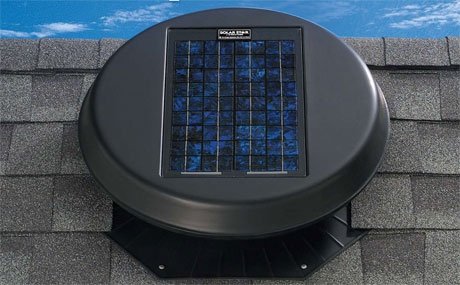When it comes to installing roof ventilation, most people think of the benefits a vent can offer during the hot months of summer, drawing hot, humid air out of the house to keep the house cooler – and to reduce the burden on the air conditioning system. But that’s just one half of the story. While roof ventilation systems can offer amazing benefits during the hot, sultry months of summer, they also provide some pretty important advantages for the winter months as well.

Winter roof ventilation with Solar Star
Preventing Moisture Build-up
A good roof ventilation system doesn’t just let air out of your home. It also promotes circulation of the air inside your home. When air is still and warmed by your home’s heating system, pockets of moisture can begin to form – not just in your attic, but in other areas of your home as well, including inside your walls. Moisture build-up can occur rapidly when the outside air is cooler than the air indoors, causing condensation to form along the outer walls and roof, as well as the joists and studs that support them.
And with that moisture come other problems, like mould and mildew growth which can cause some pretty serious health issues as well as triggering allergies and asthma. Mould and mildew like a warm, damp environment, and the lack of circulation also enables mould spores to propagate more efficiently. Over time, mould growth and related rot can compromise not only your health, but the integrity of your walls, floors and joists, resulting in a major repair bill that can set you back tens of thousands of dollars.
The simple solution? Improve your home’s airflow. By increasing the circulation of the air inside your home and ridding it of hot, moist air, you deprive mould spores of the elements it needs to grow and spread. Your home is kept drier and healthier, not just in summer, but all year round.
Whirlybirds and Static Vents vs. Powered Vents
When it comes to venting your roof, there are three primary options: Whirlybirds, static (non-powered) roof vents and roof vents that use powered fans to draw heat up and out of your home. Of the three, static vents offer the least benefit, providing a simple “hole” to enable rising air to exit the house without doing anything to increase that movement. Whirlybirds are more helpful, using the convection of rising heat to move the whirlybird turbine and draw a little more air out the home. But of all three options, powered vents are by far the most effective, using a motor to actively move air out of the home to promote better circulation throughout.
In this simple comparison, the choice seems obvious: Powered vents are the way to go. But “traditional” powered vents have a drawback – they use electricity, and over time, the usage costs can be high. Solatube’s Solar Star attic fans provide homeowners with a solution that combines the best of both worlds, using a solar-powered fan for optimal circulation without the need for costly electricity to operate it. In fact, data shows the Solar Star can provide as much ventilation as 10 to 15 whirlybirds! Plus, just like Solatube’s skylights, installation of the Solar Star is simple and vent is backed by Solatube’s industry-leading warranty.
Solar Star is the green roof ventilation solution. It has a leak-proof, slimline profile, whisper-quiet and efficient motor, and the benefit of quick installation. If you want to explore the benefits of installing a Solar Star in your roof cavity this winter, contact Solatube today.


Hi could someone help,
Got approx 15m2 roof cavity i have insulated on top of plaster and on the pitch under the roof sheets both 90mm r2.5 thick layer of earthwool, under the roof sheets is a layer of r1.5 foil insulation, when i installed this noticed little bit of mould where the exhaust fan in bathroom, would like to put a duct so that steam goes outside the roof cavity with a auto close vent and then a solar roof vent to suit my roof can u help with which one is the best for my application
Hi Marc
We always recommend venting bathroom ventilation directly out to open air. Venting bathroom moisture into the roof cavity is a common cause of mould in roof cavities. While the solar star is also a solution for preventing moisture build up, you should also consider the heat impact on your home. Keeping in mind insulation ranges between R1.5-7 and while it stops heat it will also trap it after consecutive hot days. This heat build-up in the roof cavity may still transfer into the home and if you are noticing this heat transfer the solar star is a great solution to remove heat and prevent moisture build up.
In this article you will get to know about the importance of roof ventilation during winter. It is a wonderful article, and attracting mostly everyone in the world. I enjoyed reading this article and would suggest others to come In this particular blog and get all the information regarding the topic.This Moisturebarrier.co.nz is very useful and its related to what you have actually mentioned here.
HI MAY NAME IS NADIA RODIONOV . I”M LIVING IN GRANY FLAT ON WEELS. KIND OF CARAVAN AND I HAVE A BIG PROBLEM WITH CONDENZATION, THE WALLS IN THE UNIT ARE LIKE MELAL SHEETS NOT A GIPROK. WILL THE RUTH FAN HEALP, AND WILL BE NOT TO COLD FOR ME IF THE HOT AIR IS WITHROWAL OUT
THANKS
Hi Nadia,
The Solar Stars are designed for home ventilation and need to be installed on a roof of the home, it would not suit your application.